Ablation of RhoA impairs Th17 cell differentiation and alleviates house dust mite-triggered allergic airway inflammation
- PMID: 31260596
- PMCID: PMC7747217
- DOI: 10.1002/JLB.3A0119-025RRR
Ablation of RhoA impairs Th17 cell differentiation and alleviates house dust mite-triggered allergic airway inflammation
Abstract
Asthma is a heterogeneous chronic airway inflammation in which Th2 and Th17 cells are key players in its pathogenesis. We have reported that RhoA of Rho GTPases orchestrated glycolysis for Th2 cell differentiation and allergic airway inflammation by the use of a conditional RhoA-deficient mouse line. However, the role of RhoA in Th17 cells remains to be elucidated. In this study, we investigated the effects of RhoA deficiency on Th17 cells in the context of ex vivo cell culture systems and an in vivo house dust mites (HDM)-induced allergic airway inflammation. We found that RhoA deficiency inhibited Th17 differentiation and effector cytokine secretion, which was associated with the downregulations of Stat3 and Rorγt, key Th17 transcription factors. Furthermore, loss of RhoA markedly suppressed Th17 and neutrophil-involved airway inflammation induced by HDM in mice. The infiltrating inflammatory cells in the lungs and bronchoalveolar lavage (BAL) fluids were dramatically reduced in conditional RhoA-deficient mice. Th17 as well as Th2 effector cytokines were suppressed in the airways at both protein and mRNA levels. Interestingly, Y16, a specific RhoA inhibitor, was able to recapitulate the most phenotypes of RhoA genetic deletion in Th17 differentiation and allergic airway inflammation. Our data demonstrate that RhoA is a key regulator of Th17 cell differentiation and function. RhoA might serve as a potential novel therapeutic target for asthma and other inflammatory disorders.
Keywords: RhoA; Th17; Y16; allergic airway inflammation; house dust mite.
©2019 Society for Leukocyte Biology.
Conflict of interest statement
CONFLICTS OF INTEREST
The authors declare no conflicts of interest.
Figures
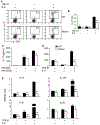

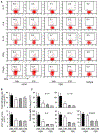
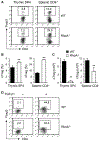
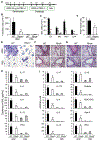

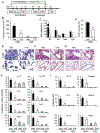

Similar articles
-
PKCλ/ι regulates Th17 differentiation and house dust mite-induced allergic airway inflammation.Biochim Biophys Acta Mol Basis Dis. 2018 Mar;1864(3):934-941. doi: 10.1016/j.bbadis.2018.01.001. Epub 2018 Jan 3. Biochim Biophys Acta Mol Basis Dis. 2018. PMID: 29305916
-
Dectin-2 promotes house dust mite-induced T helper type 2 and type 17 cell differentiation and allergic airway inflammation in mice.Am J Respir Cell Mol Biol. 2014 Aug;51(2):201-9. doi: 10.1165/rcmb.2013-0522OC. Am J Respir Cell Mol Biol. 2014. PMID: 24588637
-
Concomitant suppression of TH2 and TH17 cell responses in allergic asthma by targeting retinoic acid receptor-related orphan receptor γt.J Allergy Clin Immunol. 2018 Jun;141(6):2061-2073.e5. doi: 10.1016/j.jaci.2017.07.050. Epub 2017 Sep 22. J Allergy Clin Immunol. 2018. PMID: 28943467 Free PMC article.
-
RhoA/Rho-kinases in asthma: from pathogenesis to therapeutic targets.Clin Transl Immunology. 2020 Apr 29;9(5):e01134. doi: 10.1002/cti2.1134. eCollection 2020 May. Clin Transl Immunology. 2020. PMID: 32355562 Free PMC article. Review.
-
Th17-mediated inflammation in asthma.Curr Opin Immunol. 2013 Dec;25(6):755-60. doi: 10.1016/j.coi.2013.08.002. Epub 2013 Sep 11. Curr Opin Immunol. 2013. PMID: 24035139 Free PMC article. Review.
Cited by
-
RhoA and Cdc42 in T cells: Are they targetable for T cell-mediated inflammatory diseases?Precis Clin Med. 2021 Jan 7;4(1):56-61. doi: 10.1093/pcmedi/pbaa039. eCollection 2021 Mar. Precis Clin Med. 2021. PMID: 33842837 Free PMC article.
-
Graded RhoA GTPase Expression in Treg Cells Distinguishes Tumor Immunity From Autoimmunity.Front Immunol. 2021 Oct 15;12:726393. doi: 10.3389/fimmu.2021.726393. eCollection 2021. Front Immunol. 2021. PMID: 34721389 Free PMC article.
-
Potential role of RhoA GTPase regulation in type interferon signaling in systemic lupus erythematosus.Arthritis Res Ther. 2024 Jan 20;26(1):31. doi: 10.1186/s13075-024-03263-3. Arthritis Res Ther. 2024. PMID: 38243295 Free PMC article.
-
Role of Rho GTPases in inflammatory bowel disease.Cell Death Discov. 2023 Jan 23;9(1):24. doi: 10.1038/s41420-023-01329-w. Cell Death Discov. 2023. PMID: 36690621 Free PMC article. Review.
-
The role of GLS1-mediated glutaminolysis/2-HG/H3K4me3 and GSH/ROS signals in Th17 responses counteracted by PPARγ agonists.Theranostics. 2021 Mar 4;11(9):4531-4548. doi: 10.7150/thno.54803. eCollection 2021. Theranostics. 2021. PMID: 33754076 Free PMC article.
References
Publication types
MeSH terms
Substances
Grants and funding
LinkOut - more resources
Full Text Sources
Medical
Molecular Biology Databases
Miscellaneous

